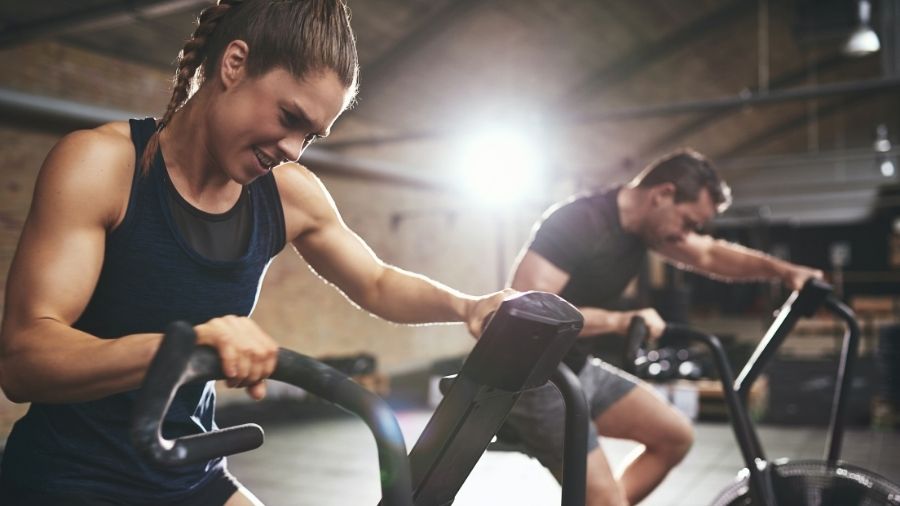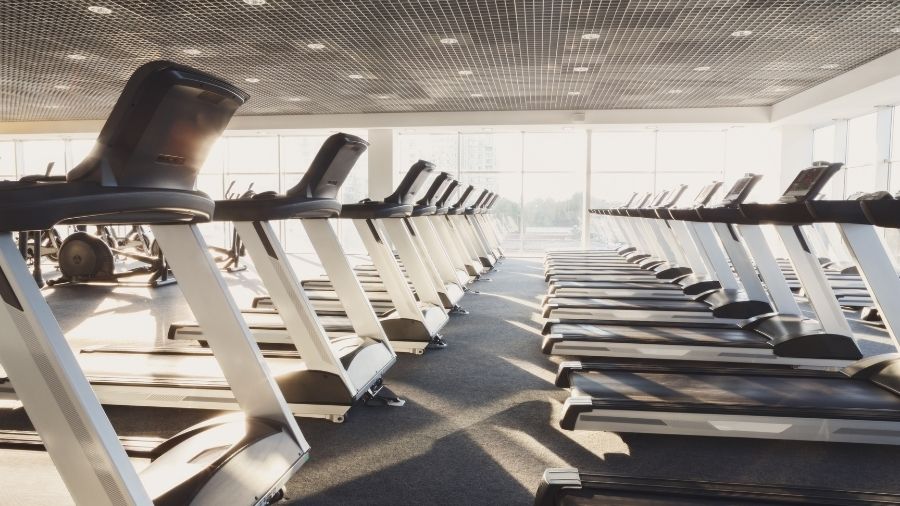Doing cardio before or after weights is known as concurrent training. That is training two distinctly different qualities (strength and endurance) within the same session, day, or week. The concurrent training effect, also known as the interference effect, was first discovered in the 1980s where it was originally found that weight training and cardio resulted in fewer strength gains than those who purely trained with weights [1].
Cardio should be performed after weights when to goal is strength and size and cardio before weights when the goal is endurance. However, to maximize strength or endurance adaptations, cardio and weights should be separated by 24 hours.
Since this 1980 study, a plethora of research has been published on whether you should do cardio before or after weights. So, I’m going to put this question to bed once and for all.
Table of Contents
Should You Do Cardio Before Or After Weights?
Whether to do cardio before or after weights is a loaded question. There are so many variables at play that “it depends” is often the unhelpful answer. But I’m not here to provide you with unhelpful answers. Here are the quick bullet points before I break this down:
Those who are time-crunched will often opt for this approach. Head to the gym, either do cardio or weights first then finish the session with the other modality. While it is not optimal in the long term, you can make it work!
Your Goal Is Size And Strength
If your goal is to be big and strong, then you must perform your weight training first then follow it with your cardio [2]. For example, 15 x 1-minute high-intensity cycling or running before weight training reduced half-squat performance compared to those who only performed the half squat [4].
However, you should only do this for short training cycles as, over the long term, cardio after weights can blunt the adaptations from lifting weights [3].
If you are well-trained and haven’t performed cardio after weight training before, the novel stimulus can potentially give you quick cardio adaptations even at low volumes [2]. Again, this should be performed over short periods.
Your Goal Is Endurance

The general rule is to train your priority first. So, if your main goal is aerobic endurance, then you should perform cardio before weights. However, a recent meta-analysis states that training sequence has no impact on aerobic endurance [5].
Taking a common-sense approach, this will highly depend on how much volume you perform in your weight training session and whether or not you are using similar muscle groups. For example, if you trained legs before going for a run, you probably know from experience that it doesn’t end well. And performing high-intensity leg training has been shown to reduce running time to exhaustion for up to 24 hours after [7].
Interestingly, previous research has stated that you can enhance the endurance training response by performing strength training directly after low-intensity endurance training as it does not affect strength training adaptations [6].
You Are A Beginner
Beginners can essentially get away with anything. In fact, endurance training and weight training both signal the endurance and muscle-building pathways meaning beginners can get bigger, stronger, and fitter by performing only endurance or only weight training [2].
Therefore, no concurrent training effect is seen in these individuals so cardio can be performed either before or after weights.
Males vs. Females
Continuing from beginners, beginner males don't seem to see any negative effects with cardio before or after weights. Novice females however show greater strength and muscle growth adaptations when cardio is performed after weights compared to before weights [8].
Is Cardio After Weights Bad?
Doing cardio after weights, when your goal is to maximize strength and muscle size, is bad in the long term. Cardio and weight training signal opposite adaptations within the body. Weight training signals what is known as the mTOR pathway which stimulates muscle protein synthesis [2].
In layman's terms, that is stimulating the process of creating new proteins which are essentially building and repairing muscle mass. Cardio on the other hand stimulates the AMPK pathway. This pathway stimulates aerobic endurance adaptations.
However, the AMPK pathway severely inhibits the mTOR pathway meaning it limits the muscle growth response [6]. Therefore, if cardio is done after weights for months on end, you will reduce your gains in strength and size.
Why You Should Not Do Cardio Before Weights

If endurance is your primary goal, then doing cardio before weight training might be a good idea on some training days. I say some because the reason cardio is not seen as a good idea before weights are the local muscular fatigue that occurs [5].
For example, after a 45-minute submaximal cycling session, max reps to failure were reduced for the back squat but not the bench press [9]. If you plan your training correctly, you could perform lower body cardio before upper body strength training days.
Further, growth hormone secretion is reduced after weight training when cardio is performed before for up to 60 minutes [11]. Acute increases in growth hormone and their effect on muscle growth are dubious [12].
For example, when injecting adults with 2-4 times the daily adult growth hormone secretion rate while weight training for 12 weeks, it led to no difference in muscle size or strength compared to the non-injected group [13].
However, the reduction in growth hormone may suggest an impairment in the anabolic processes and therefore, may best be avoided [14].
How Long Should You Wait To Do Cardio After Lifting Weights?
Many individuals will perform their cardio directly after lifting weights. It makes sense. You’re already at the gym and you’re not going to go twice especially if you have a family and work full time. Just know that doing this will reduce your ability to get stronger and increase muscle size.
If you’re looking to maximize endurance and strength and size gains, then separating cardio and weights sessions by 3-6 hours is enough to reduce the interference effect [6]. Ideally, you would separate these sessions by 24 hours [10]. Therefore, one day would be geared towards weight training and the other to cardio.
In an ideal world where time is no obstacle and all you care about is maximizing gains, high-intensity cardio should be performed in the morning. It only takes approximately 3 hours for the stimulation of AMPK to return to baseline. Then in the afternoon, hit the weights. mTOR activation can last up to 18 hours so you get the best of both worlds [6].
Cardio Before Or After Workout For Weight Loss?

For weight loss, performing cardio after your weight training workout is best for fat metabolism. This has been shown where resistance training 20 minutes and 120 minutes before endurance exercise resulted in greater fat metabolism compared to endurance exercises alone [14].
Another factor to take into consideration is the main goal of weight loss. It is to retain as much muscle as possible while reducing body fat. That means training should be set up where it maximizes the anabolic signaling of muscle growth (mTOR pathway) and minimizes any interference effect (AMPK pathway).
Ideally, weight training workouts and cardio workouts should be separated by a day to maximize weight loss while retaining muscle mass.
What Type Of Cardio Should You Pair With Lifting Weights?
If you must perform your cardio after weight training, it seems that low volume (1-2 km), short bursts (4-10 min) of high-intensity interval training (HIIT), or sprint interval training (SIT) have the least negative effect on weight training adaptations [2].
This is because high volume/long distance, long duration (>20 min), and moderate-intensity exercise increase AMPK signaling due to the dose-response relationship with endurance training load [2]. Therefore, low volume, high-intensity cardio is best to perform after weights.
If performing cardio before weights for endurance purposes, low-intensity and low-moderate volume carry less fatigue to strength training which enhances the endurance adaptations [6].
Summary
Most of the advantages lie with performing cardio after weights. Cardio before weights may be beneficial for those looking to prioritize aerobic adaptations. However, good planning should be done to ensure you are not performing weight training with the same muscle groups.
Ideally, instead of performing cardio before or after weights, you should try to split these sessions up with alternating days. For example, weights on Monday and cardio on Tuesday.
References
1. Hickson, R. C. (1980). Interference of strength development by simultaneously training for strength and endurance. European journal of applied physiology and occupational physiology, 45(2), 255-263.
2. Methenitis, S. (2018). A brief review on concurrent training: from laboratory to the field. Sports, 6(4), 127.
3. Coffey, V. G., & Hawley, J. A. (2017). Concurrent exercise training: do opposites distract?. The Journal of physiology, 595(9), 2883-2896.
4. Panissa, V. L., Tricoli, V. A., Julio, U. F., Ribeiro, N., de Azevedo Neto, R. M., Carmo, E. C., & Franchini, E. (2015). Acute effect of high-intensity aerobic exercise performed on treadmill and cycle ergometer on strength performance. The Journal of Strength & Conditioning Research, 29(4), 1077-1082.
5. Murlasits, Z., Kneffel, Z., & Thalib, L. (2018). The physiological effects of concurrent strength and endurance training sequence: A systematic review and meta-analysis. Journal of sports sciences, 36(11), 1212-1219.
6. Baar, K. (2014). Using molecular biology to maximize concurrent training. Sports Medicine, 44(2), 117-125.
7. Doma, K., Deakin, G. B., & Bentley, D. J. (2017). Implications of impaired endurance performance following single bouts of resistance training: an alternate concurrent training perspective. Sports Medicine, 47(11), 2187-2200.
8. Taipale, R. S., Schumann, M., Mikkola, J., Nyman, K., Kyröläinen, H., Nummela, A., & Häkkinen, K. (2014). Acute neuromuscular and metabolic responses to combined strength and endurance loadings: the “order effect” in recreationally endurance trained runners. Journal of Sports Sciences, 32(12), 1155-1164.
9. Reed, J. P., Schilling, B. K., & Murlasits, Z. (2013). Acute neuromuscular and metabolic responses to concurrent endurance and resistance exercise. The Journal of Strength & Conditioning Research, 27(3), 793-801.
10. Robineau, J., Babault, N., Piscione, J., Lacome, M., & Bigard, A. X. (2016). Specific training effects of concurrent aerobic and strength exercises depend on recovery duration. The Journal of Strength & Conditioning Research, 30(3), 672-683.
11. Goto, K., Higashiyama, M., Ishii, N., & Takamatsu, K. (2005). Prior endurance exercise attenuates growth hormone response to subsequent resistance exercise. European journal of applied physiology, 94(3), 333-338.
12. Schoenfeld, B. J. (2013). Postexercise hypertrophic adaptations: a reexamination of the hormone hypothesis and its applicability to resistance training program design. The Journal of Strength & Conditioning Research, 27(6), 1720-1730.
13. Yarasheski, K. E., Campbell, J. A., Smith, K., Rennie, M. J., Holloszy, J. O., & Bier, D. M. (1992). Effect of growth hormone and resistance exercise on muscle growth in young men. American Journal of Physiology-Endocrinology And Metabolism, 262(3), E261-E267.
14. Goto, K., Ishii, N., Sugihara, S., Yoshioka, T., & Takamatsu, K. (2007). Effects of resistance exercise on lipolysis during subsequent submaximal exercise. Medicine & Science in Sports & Exercise, 39(2), 308-315.
